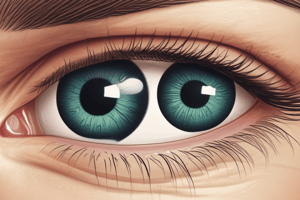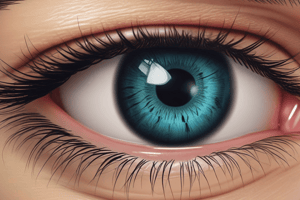Podcast
Questions and Answers
What is the primary impact of high water content lenses on eye opening?
What is the primary impact of high water content lenses on eye opening?
- They lose more water than low water content lenses. (correct)
- They enhance corneal deswelling.
- They reduce the availability of oxygen to the cornea.
- They prevent lens shrinkage when worn.
Which design consideration is most likely to affect the centration and comfort of a lens?
Which design consideration is most likely to affect the centration and comfort of a lens?
- The permeability of the lens.
- The thickness of the lens.
- The water content of the lens.
- The movement of the lens. (correct)
How does the lens thickness influence tear film interaction?
How does the lens thickness influence tear film interaction?
- Thicker lenses increase the likelihood of edema. (correct)
- Thicker lenses promote better oxygen transmission.
- Thicker lenses enhance tear film stability.
- Thicker lenses do not affect tear film interaction.
What is the consequence of lens shrinkage in high water content lenses?
What is the consequence of lens shrinkage in high water content lenses?
How does the Dk/t value relate to lens design in terms of preventing edema?
How does the Dk/t value relate to lens design in terms of preventing edema?
What is the maximum recommended frequency for intermittent extended wear of contact lenses?
What is the maximum recommended frequency for intermittent extended wear of contact lenses?
What is the main consequence of wearing contact lenses longer than recommended?
What is the main consequence of wearing contact lenses longer than recommended?
How does the thickness of a contact lens affect oxygen transmission?
How does the thickness of a contact lens affect oxygen transmission?
Why is tear mixing considered minimal under soft contact lenses?
Why is tear mixing considered minimal under soft contact lenses?
What is a characteristic of overnight edema caused by contact lens wear?
What is a characteristic of overnight edema caused by contact lens wear?
What should be the focus concerning corneal swelling when wearing contact lenses?
What should be the focus concerning corneal swelling when wearing contact lenses?
Which statement about daily wear versus extended wear contact lenses is correct?
Which statement about daily wear versus extended wear contact lenses is correct?
What happens to the edema cycle with continuous contact lens wear?
What happens to the edema cycle with continuous contact lens wear?
What primarily prevents an instantaneous response from the soft lens during fitting?
What primarily prevents an instantaneous response from the soft lens during fitting?
How does lens relaxation affect the post-lens tear film after blinking?
How does lens relaxation affect the post-lens tear film after blinking?
What role does tear film thickness play in lens movement dynamics?
What role does tear film thickness play in lens movement dynamics?
What characteristic of hydrogel lenses is influenced during blinking?
What characteristic of hydrogel lenses is influenced during blinking?
Which aspect of a soft lens fitting can be described by the acronym BOZR?
Which aspect of a soft lens fitting can be described by the acronym BOZR?
Which property of soft lenses causes a slower response during the fitting process?
Which property of soft lenses causes a slower response during the fitting process?
What happens to the post-lens tear film when the lens is too thick?
What happens to the post-lens tear film when the lens is too thick?
What effect does the lack of lens movement have on tear mixing under soft contact lenses?
What effect does the lack of lens movement have on tear mixing under soft contact lenses?
Flashcards are hidden until you start studying
Study Notes
Soft Contact Lens Tear Mixing
- Hydrogel lens deformation during blinking and lens alignment with anterior eye topography induce visco-elastic forces
- These forces cause a lag in lens relaxation behind lid retreat
- The force to move the lens is inversely proportional to the tear film thickness
- Visco-elastic properties of the lens prevent an instantaneous response to lid retreat
- The lens relaxation may involve movement or volume change of the post-lens tear film
- A thin post-lens tear film is mainly composed of viscous mucin and lipids
Soft Contact Lens Fitting Philosophy
- Intended lens usage is relevant to fitting considerations as extended wear (EW) and daily wear (DW) lenses require different levels of oxygen permeability
- For EW: cornea’s minimum oxygen requirement must be met due to the longer wear time, which exacerbates oxygen deprivation
- For DW: less open eye requirements apply
- EW always requires higher oxygen transmission than DW
Oedema Cycle
- Oedema occurs whenever a contact lens is worn, as the lack of oxygen causes corneal swelling
- Overnight wear results in corneal oedema
- Incomplete deswelling during the day leads to persistent chronic residual daytime oedema
Overnight Lens Wear
- Less oxygen is available with overnight lens wear
- Oedema depends on the Dk/t of the lens
- Dk/t depends on the lens thickness and thicker lenses allow for less oxygen transmission
High Water Content Lenses
- These lenses lose more water than low water content lenses on the eye
- They lose water even when worn in a high humidity environment
- Lens shrinkage on eye affects the tear distribution and base curve radius (BOZR)
- This impacts fit and needs to be taken into account
On Eye Opening
- Corneal deswelling occurs, improving the condition of the eye as more oxygen becomes available
- Hydrogel lenses allow for 8% oxygen permeation (Dk/t)
- Rigid gas permeable (RGP) lenses with Dk/t of 10-11% provide better oxygen transmission than hydrogels
- RGP lens performance stems from greater permeability, tear pump action
Preventing Oedema
- Daily wear (DW) lenses require a Dk/t of 24 to allow for 9.9% oxygen transmission
- Extended wear (EW) lenses need a Dk/t of 87 to allow for 17.9% oxygen transmission
- All currently available hydrogel lenses cause greater than 8% overnight oedema
SCL Design Considerations
- Centralization of the lens is important for vision, comfort, and mechanical function
- Lens movement is beneficial for debris clearance and comfort
- The 4C’s relate to the quality of the lens fit: Coverage, Centration, Comfort, Clarity
Tear Mixing
- Studies show little tear mixing occurs under soft contact lenses
- Corneal swelling is related to local Dk/t, which is determined by the thickness of the lens at a specific point
- Lens thickness is a crucial factor in contact lens fitting
Studying That Suits You
Use AI to generate personalized quizzes and flashcards to suit your learning preferences.




